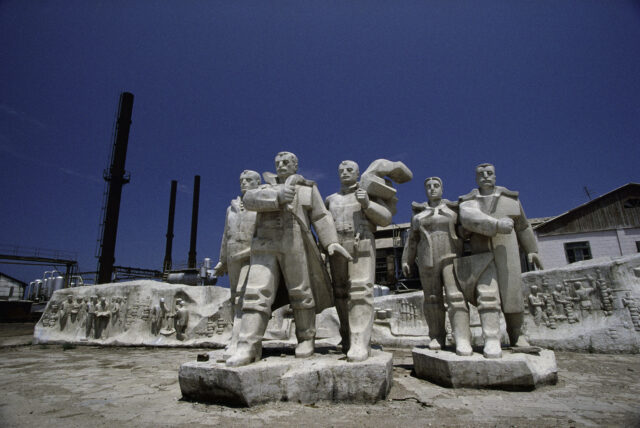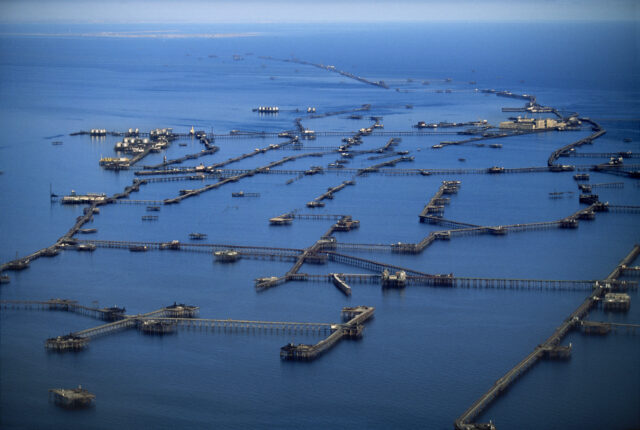In the middle of the Caspian Sea, about 25 miles from the coast of Azerbaijan, lies a city built on oil and dreams. Neft Dashlari – or “Oily Rocks” – is a Soviet-era offshore oil city that was once a hub bustling with activity. Originally designed to exploit the rich oil reserves beneath the Caspian Sea, it’s begun to slowly sink beneath the waves. Abandoned and decaying, the industrial settlement has become an eerie, almost dystopian landscape of rusting metal and collapsing infrastructure.
Oil deposits were discovered in the Caspian Sea

Neft Dashlari’s story begins in the late 1940s, when Soviet geologists discovered a significant oil deposit beneath the Caspian Sea. In 1949, construction began on what would become the world’s first offshore oil platform.
Initially, the city was built on seven sunken ships, including the first oil tanker, creating a stable base for drilling operations. By 1951, the first dredges of oil were extracted, marking the beginning of Neft Dashlari’s rapid expansion.
Expansion of Neft Dashlari

Neft Dashlari’s early years were marked by intense construction and innovation. Engineers and workers toiled day and night to build a network of platforms connected by trestle bridges. These platforms housed not only drilling rigs, but also living quarters, cultural spaces and recreational facilities.
The city quickly grew, reflecting the Soviet Union’s ambition to dominate global oil production. By the mid-20th century, Neft Dashlari had become a symbol of Soviet engineering prowess and industrial might.
Neft Dashlari’s Golden Age

The 1970s marked the Golden Age of Neft Dashlari. It expanded exponentially, with new platforms and bridges being constructed at a staggering pace. At its peak, the city boasted around 2,000 drilling platforms, all connected by over 200 miles of bridges.
Neft Dashlari was home to a thriving community of workers and their families, complete with apartment blocks, bakeries, soccer fields, cinemas and even parks, where residents cultivated soil from the mainland to grow their own produce.
Industrial hub and vibrant community

During this period, Neft Dashlari wasn’t just an industrial hub, but also a vibrant community. The introduction of underwater pipelines and an airstrip for transporting vehicles to the city further boosted its capabilities.
Perhaps most importantly, the city developed a system to supply itself with fresh drinking water, a significant achievement given its isolated location. Life on the “Oily Rocks” was exciting and profitable.
Inevitable decline of Neft Dashlari

The collapse of the Soviet Union marked the beginning of Neft Dashlari’s decline. Azerbaijan declared its independence, and the once-thriving oil city faced fierce competition from new oil fields around the world.
The population dwindled, and the infrastructure, once a marvel of engineering, started to deteriorate. Seawater began to reclaim parts of Neft Dashlari, and many of the bridges and platforms fell into disrepair.
Shadow of its former glory

Today, Neft Dashlari is a shadow of its former self. Its population has dwindled from a peak of about 5,000 people to around 2,000. Additionally, of the original 200 miles of bridges, only 20 structures remain usable after falling into disrepair.
Other damage suffered by the city include a large flood that took out the first two floors of some apartment buildings, as well as broken steel beams that crisscross below the water, creating navigational hazardous for boats and ships.
In an effort to try and convince people to remain in Neft Dashlari, workers were offered higher wages, but, for many, it wasn’t enough to stay on the crumbling, floating city.
What does the future have in store for Neft Dashlari?

In 2009, Neft Dashlari celebrated its 60th anniversary, having produced 170 million tons of oil and natural gas since its founding. However, the city’s future remains uncertain. Experts estimate there are still 30 million tons of oil beneath the seabed, enough for about 30 more years of drilling, but as the reserves dwindle, so, too, does the settlement’s viability.
Sinking beneath the water’s surface

Infrastructure keeps on decaying, raising questions as to whether it’s safe to continue operations on Neft Dashlari. As it continues to sink, its residents face the challenge of reintegrating into life on the mainland.
More from us: Picher, Oklahoma Is America’s Most Toxic Ghost Town
Want to become a trivia master? Sign up for our Today In History newsletter!
Access to the city is tightly controlled, and, mysteriously, it doesn’t appear on Google Earth. For now, Neft Dashlari continues to stand, but whether it will be preserved as a historical site or left to disappear beneath the waves remains to be seen.
